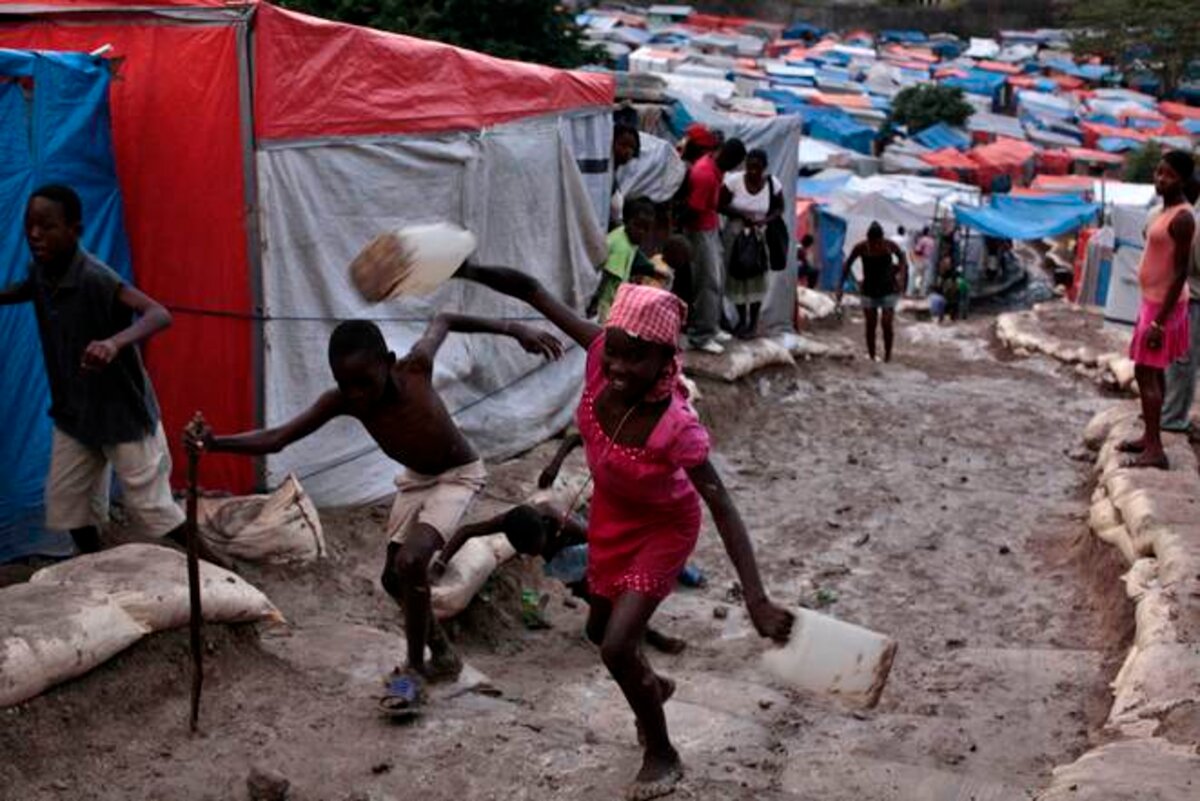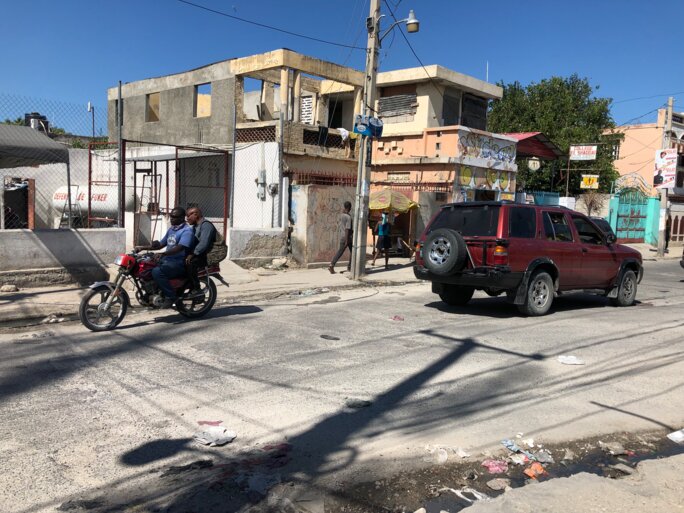What is probably the biggest international scandal of the past decade centres on the impoverished Caribbean state of Haiti, and implicates the United Nations, dozens of donor countries including European Union member countries and the United States, major corporations, legions of consultants, as well as political parties and their leaders.
All were active or passive participants in a gigantic so-called “humanitarian” operation that followed the magnitude 7 earthquake that devastated large swathes of Haiti on January 12th 2010. The initial quake and the powerful aftershocks are estimated by the local authorities to have killed which between 250,000-300,000 people, injuring hundreds of thousands of others, and leaving at least 1.5 million people homeless.
The ensuing aid operation ended up in outrageous financial waste, including massive embezzlement and industrial corruption. Nearly 11.5 billion dollars has been officially handed to Haiti since 2010, and which does not include major private donations and the solidarity of the Haitian diaspora.

Enlargement : Illustration 1

The commemorations last Sunday marking the ten years since the quake struck were doubly sad, bringing both poignant homage to the dead while highlighting the intolerable situation in which the survivors live today. The principal ceremony was held at a memorial in the Morne Saint-Christophe, just north of the capital Port-au-Prince, where thousands of victims were buried in common graves. The memorial, still uncompleted, is already dilapidated.
Also on Sunday, a model of the new National Palace building – the seat of the Haitian presidency – was presented. The former palace building was destroyed by the quake, and at one time France had proposed taking charge of its reconstruction. Today, the site is a wasteland that has remained so ever since the J/P Haitian Relief Organization, an NGO co-founded by Hollywood star Sean Penn, evacuated the ruins of the old building.
The day was very much a reflection of the decade that has passed. Haiti is a devastated country, sunk in violent social and political crises, and poverty is now more widespread than before 2010. The state is no longer simply bankrupt, as experts described it before the quake, it is quite simply no longer present, disappeared, leaving Haiti’s population of more than ten million at the mercy of the clan that holds presidential power and criminal gangs which control large parts of the country.
Since Monday, the Haitian republic no longer has an active parliament because the mandates of its members have now reached expiry date, and no fresh elections, which should have been held in October, had been approved. No public budget has been voted since the past three years, the economy is in recession and inflation has shot up. Basic services, like education, health and the administration, are either barely maintained or not at all.
Haitian President Jovenel Moïse is rejected by every political party other than his own, and also by large sections of the economic world and all the organisations in civil society. Since Monday, he governs by decree, personally protected by several hundred troops and mercenaries hired from US mercenary security firm Academi (formerly called Blackwater).
But the negligence and corruption of the country’s political class, the violence of its elites towards a population living in misery, and the predation of national wealth by around a dozen families – who together own about 80% of the country’s economy – is not enough to explain the current disaster. The deplorable situation is also the responsibility of the international community, of the major players in “aid” programmes who, over the past ten years, have accelerated the destruction of Haiti.
“Abandoned, undressed, naked, Port-au-Prince was not however obscene,” wrote Haitian novelist Yanick Lahens, who has played an active role in her country’s cultural and social affairs, in her book Failles (Flaws) published just a few months after the 2010 quake. “What was, was its forced nakedness. What was obscene and remains so is the scandal of its poverty.” In a contribution last month to French daily Le Monde, which had invited writers to look back at marking events of the passing decade, when she focussed on the quake, she concluded that, “Haiti has an exemplary place in all the genealogy of the modern factory of poverty”.
Marking the tenth anniversary of the quake, Haitian poet and novelist Lyonel Trouillot wrote a tribune on Mediapart this week. “The catastrophe here is an odious permanence,” he declared. “A catastrophe that has endured for ten years and perpetuates itself, but of which today the ugliness is naked.”
From the beginning of the 2000s, well before the quake, Haiti had already become nicknamed “the republic of NGOs”. Placed under trusteeship by the United Nations (UN) in 2004, when an armed peacekeeping force, the MINUSTAH “stabilisation mission”, was sent to Haiti, the country was to become a sort of experimentation laboratory for the maddest of humanitarian kind souls. Jumping into the breach left by a state in crisis and failure, all sorts of NGOs became engaged in a competition of inventiveness. Without regard for the solid and experienced NGOs, nor, above all, the Haitians, what Yanick Lahens called “the factory of modern poverty” could begin in the name of good; consultants, experts, associations of all kinds, evangelical sects and numbers of visionaries came to “save” Haiti, each with their opinions, methods and funds.
It was this same process that was repeated after the 2010 quake’s destruction of Port-au-Prince and several other major towns in the country. Ban Ki-moon, then Secretary-General of the UN, self-proclaimed “friend” of Haiti, placed Bill Clinton, another friend of Haiti, as co-chairman of the Interim Haiti Recovery Commission (IHRC), along with Haitian Prime Minister Jean-Max Bellerive. It was a move intended to reassure the countries donating aid – and also the US Congress – that the billions of dollars to come would be used properly.
'A laboratory of kleptomania, of humanitarian nonchalance'
What happened next is a catalogue of scandals, warnings, alarm-raising reports, failures, embezzlement, anger and despair. The IHRC soon demonstrated itself to be a bureaucratic monstrosity. Dozens of millions of dollars were swallowed up by consultancy bodies (the Foundation for the Built Environment founded by Britain’s Prince Charles was given 300,000 dollars for its project to rebuild a part of the capital’s old quarter), including in absurd projects for so-called “model” villages to provide provisional re-lodging of the homeless, and which today remain without supplies of drinking water or electricity.
“The reconstruction promised by the international community remains invisible,” wrote Frantz Duval, editor of Haiti’s largest francophone daily, Le Nouvelliste, in an article published on Sunday under the title 'The lost decade'. “The aid providers and the recipients of aid entered into an understanding on how to misappropriate the best: hope and billions.”
Jean-Euphèle Milcé, a writer and director of Le National, Haiti’s other francophone daily, echoed that conclusion in an editorial published last weekend, entitled “Ten years after”: “Ten years later […] the Haitian people would like to understand why and how the reconstruction has not even begun,” he said. “It is an enigma that is difficult to pierce because the cynicism of those involved, humanitarians as much as politicians, has been outrageously crude. The quake of January 12th was a veritable laboratory of kleptomania, of humanitarian nonchalance, to a background of opportunity-seeking.”

Enlargement : Illustration 2

Throughout those ten years, corruption and embezzlement have been recurrently documented, and set against the complete impunity of those involved. Between 2010 and 2015, the American Red Cross humanitarian organisation received 486 million dollars in donations for aid to Haiti, from which just six permanent houses were built. Meanwhile, the United States agency for international development, USAID, an agency of the federal government, freed 2.5 billion dollars in aid for Haiti. Of that sum, 2.6% was handed to Haitian firms and associations, while 54% went to US companies (see more at the Washington-based Center for Economic and Policy Research blog monitoring the use of multinational aid in Haiti ).
Large corporations from the Dominican Republic, Haiti’s neighbour on the Caribbean island of Hispaniola, benefited massively from rigged reconstruction contracts, many of which were later abandoned. Construction companies from Canada, one of the major donor countries, made enormous profits from rebuilding contracts. Meanwhile, one of Bill Clinton’s most notable inaugurations of projects completed in the country was that in 2015 of the Marriott hotel in Port-au-Prince, a surreally luxurious 175-room complex protected by heavily armed guards.
The only official reports which identify the beneficiaries of the systems of corruption, over-billing, embezzlement and abandoned building sites are those of Haiti’s national audit office, one of the few state institutions that still functions. Its reports into the PetroCaribe aid programme, worth 3.5 billion dollars over ten years – essentially an agreement with Venezuela by which Haiti could defer payment for up to 25 years on borrowed oil to allow more resources for economic and social development – revealed how at least 2 billion dollars went missing, leading to a vast movement of social protest that has swept the country for the past 18 months. Ministers, prime ministers and Haiti’s current president Jovenel Moïse are implicated in the scandal.
The World Bank, the US Congress and the Inter-American Development bank have all led investigations into the recurrent financial fiascos but none have pointed blame at the donor countries, NGOs and industrial groups concerned. The corruptors and the corrupted have been protected by reasons of state, escaping judicial proceedings which, it may be surmised, would implicate individuals beyond Haitian politicians alone.
“This corruption is not limited to Haiti,” said politically active Haitian writer and playwright Gary Victor, in an interview with Mediapart. “Look at PetroCaribe. Venezuelan officials necessarily got paid, and not only our politicians. Political parties in the US, the Dominican Republic, NGO officials, everyone came to be served in Port-au-Prince and negotiate their share.”
There is urgency for an impartial investigation into the corruption, to be led under the auspices of the UN – which has much to seek pardon for from Haitians. This notably concerns the vast cholera epidemic which was apparently caused by infected Nepalese troops from the UN peacekeeping force, MINUSTAH, who arrived after the 2010 quake. For several years the UN obstinately denied the peacekeepers’ responsibility in the epidemic, which contaminated around 800,000 people between 2010 and 2018 before it was finally eradicated. Officially, 10,000 people died from the disease, while French epidemiologist Renaud Piarroux, who helped identify the peacekeeping force as the origin of the epidemic, estimates that the fatalities number ten times more.
But only a detailed investigation, involving the judicial authorities from different countries and which will result in prosecution and trials, will allow to shed clear light on how such a vast international aid operation could have finished in such widespread pillaging. While the social protest movement over the PetroCaribe scandal is demanding that those implicated stand trial, public opinion around the world must demand a thorough investigation into the reconstruction fiasco; it is the necessary price to pay in order to restore confidence in international institutions, and notably the UN and humanitarian organisations.
-------------------------
- The original French version of this opinion article can be found here.
English version by Graham Tearse


